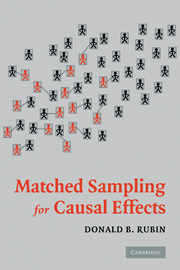Book contents
- Frontmatter
- Contents
- Contributor Acknowledgments
- Matched Sampling for Causal Effects
- My Introduction to Matched Sampling
- PART I THE EARLY YEARS AND THE INFLUENCE OF WILLIAM G. COCHRAN
- PART II UNIVARIATE MATCHING METHODS AND THE DANGERS OF REGRESSION ADJUSTMENT
- PART III BASIC THEORY OF MULTIVARIATE MATCHING
- PART IV FUNDAMENTALS OF PROPENSITY SCORE MATCHING
- PART V AFFINELY INVARIANT MATCHING METHODS WITH ELLIPSOIDALLY SYMMETRIC DISTRIBUTIONS, THEORY AND METHODOLOGY
- 15 Affinely Invariant Matching Methods with Ellipsoidal Distributions
- 16 Characterizing the Effect of Matching Using Linear Propensity Score Methods with Normal Distributions
- 17 Matching Using Estimated Propensity Scores: Relating Theory to Practice
- 18 Combining Propensity Score Matching with Additional Adjustments for Prognostic Covariates
- PART VI SOME APPLIED CONTRIBUTIONS
- PART VII SOME FOCUSED APPLICATIONS
- Conclusion: Advice to the Investigator
- References
- Author Index
- Subject Index
16 - Characterizing the Effect of Matching Using Linear Propensity Score Methods with Normal Distributions
Published online by Cambridge University Press: 05 June 2012
- Frontmatter
- Contents
- Contributor Acknowledgments
- Matched Sampling for Causal Effects
- My Introduction to Matched Sampling
- PART I THE EARLY YEARS AND THE INFLUENCE OF WILLIAM G. COCHRAN
- PART II UNIVARIATE MATCHING METHODS AND THE DANGERS OF REGRESSION ADJUSTMENT
- PART III BASIC THEORY OF MULTIVARIATE MATCHING
- PART IV FUNDAMENTALS OF PROPENSITY SCORE MATCHING
- PART V AFFINELY INVARIANT MATCHING METHODS WITH ELLIPSOIDALLY SYMMETRIC DISTRIBUTIONS, THEORY AND METHODOLOGY
- 15 Affinely Invariant Matching Methods with Ellipsoidal Distributions
- 16 Characterizing the Effect of Matching Using Linear Propensity Score Methods with Normal Distributions
- 17 Matching Using Estimated Propensity Scores: Relating Theory to Practice
- 18 Combining Propensity Score Matching with Additional Adjustments for Prognostic Covariates
- PART VI SOME APPLIED CONTRIBUTIONS
- PART VII SOME FOCUSED APPLICATIONS
- Conclusion: Advice to the Investigator
- References
- Author Index
- Subject Index
Summary
Abstract: Matched sampling is a standard technique for controlling bias in observational studies due to specific covariates. Since Rosenbaum & Rubin (1983a), multivariate matching methods based on estimated propensity scores have been used with increasing frequency in medical, educational, and sociological applications. We obtain analytic expressions for the effect of matching using linear propensity score methods with normal distributions. These expressions cover cases where the propensity score is either known, or estimated using either discriminant analysis or logistic regression, as is typically done in current practice. The results show that matching using estimated propensity scores not only reduces bias along the population propensity score, but also controls variation of components orthogonal to it. Matching on estimated rather than population propensity scores can therefore lead to relatively large variance reduction, as much as a factor of two in common matching settings where close matches are possible. Approximations are given for the magnitude of this variance reduction, which can be computed using estimates obtained from the matching pools. Related expressions for bias reduction are also presented which suggest that, in difficult matching situations, the use of population scores leads to greater bias reduction than the use of estimated scores.
INTRODUCTION
Matched Sampling
Matched sampling refers to an important class of applied statistical procedures designed to control bias in observational studies (Cochran & Rubin, 1973; Rubin, 1973a, b; McKinlay, 1977; Carpenter, 1977; Rosenbaum & Rubin, 1985a; Kane, 1991).
Information
- Type
- Chapter
- Information
- Matched Sampling for Causal Effects , pp. 249 - 262Publisher: Cambridge University PressPrint publication year: 2006
